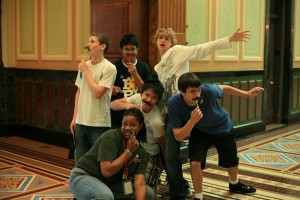Pheon Launches at American Art Museum
/https://tf-cmsv2-smithsonianmag-media.s3.amazonaws.com/filer/201105201106205008481596_723d9f07d5_b-300x200.jpg)
Some curious goings-on at the American Art Museum on Saturday afternoon may have caused a few head-turns. Visitors may have caught someone peering suspiciously behind a pedestal or curtain, or seen people with plastic ties paper clipped to their shirts. They may have wondered why some held fake mustaches to their faces, or why so many others were stepping up to gyrate with the belly dancers in the Kogod Courtyard (or why there were belly dancers to begin with). Don't believe me? Check out the photos on Flickr.
If it seemed to anyone that the American Art Museum had been transformed into some sort of alternate bizarro world, in a manner of speaking, that would have been correct. Saturday marked the launch of Pheon, the museum's new alternate reality game, which pits two warrior factions—the material-driven, but innovative, Knaves and the eco-conscious, yet at times myopic, Staves—against one another in a quest to prove humanity's worth in the strange and beautiful fantasy world, called Terra Tectus.
Nearly 160 players formed 60 teams at Saturday's event. After answering a series of short, personality-defining questions—including whether the gamer would rather untie a knot or a bow, or whether they would play offense or defense first if they could play in the NFL—each team was identified as either "Knaves" or "Staves."
John Maccabee, Pheon's head designer, says: "At the time we thought of the game , we lived in a knavish society, an era of unbridled wealth and consumerism. And yet, another current bubbling to the surface was the protection of the planet. We want to be a steward society as well." Maccabee took one look at my dangling earrings and my outfit and pronounced that I would likely be a Knave. (To vote on which one Lady Gaga would be, visit the game's Web site.)
Knaves and Staves each participated in a series of three quests, which took about 90 minutes total to complete. Clues came via text message or also on paper slips hidden throughout the museum. As the gamers scurried about the museum, they learned about several works of art, infiltrated the opposing team wearing disguises (hence the ties and mustaches) and showed off their dance skills to the belly dancers. The Staves prevailed but only just by a hair, beating out the Knaves by a handful of points.

On October 8, the game launches online and uses Facebook as home base. This will allow players to share photos and comments with each other. "We wanted to create a game with different levels of participation that would still give all players a fulfilling experience," says Georgina Goodlander, programs coordinator at the Luce Foundation Center at SAAM.
As in the museum version, players will have a variety of tasks to complete, including developing secret handshakes and doing whatever their pet wants for one hour. "Really," says Sean Mahan, one of the game's designers, "the way you can be good at Pheon is by doing a lot of stuff in the real world." Points for the game will accumulate throughout its entire run both online and museum versions, which will last through 2011.
Similar to the museum's last alternate reality game, "Ghosts of a Chance," Pheon takes place both in the museum and in a fantasy land online. Groups of ten or more can schedule a game at the museum (similar to the launch event, but unfortunately sans belly dancers). Beginning in January, the museum will host one game day per month open to all visitors. View footage from the launch, or see clips of my interview with the game designers on YouTube.
/https://tf-cmsv2-smithsonianmag-media.s3.amazonaws.com/accounts/headshot/jess-righthand-240.jpg)
/https://tf-cmsv2-smithsonianmag-media.s3.amazonaws.com/accounts/headshot/jess-righthand-240.jpg)